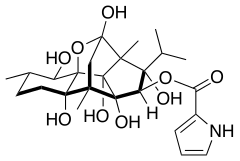 | |
| Names | |
|---|---|
| IUPAC name (1R,2R,3S,6S,7S,9S,10R,11S,12R,13S,14R)-2,6,9,11,13,14-Hexahydroxy-11-isopropyl-3,7,10-trimethyl-15-oxapentacyclo [7.5.1.01,6.07,13.010,14]pentadec-12-yl 1H-pyrrole-2-carboxylate | |
| Identifiers | |
3D model (JSmol) | |
| ChEBI | |
| ChEMBL | |
| ChemSpider | |
IUPHAR/BPS | |
| KEGG | |
| MeSH | Ryanodine |
PubChem CID | |
| UNII | |
CompTox Dashboard (EPA) | |
| |
SMILES
| |
| Properties | |
Chemical formula | C25H35NO9 |
| Molar mass | 493.547 g/mol |
Except where otherwise noted, data are given for materials in their standard state (at 25 °C [77 °F], 100 kPa). | |
Ryanodine is a poisonous diterpenoid found in the South American plant Ryania speciosa (Salicaceae). It was originally used as an insecticide.
The compound has extremely high affinity to the open-form ryanodine receptor, a group of calcium channels found in skeletal muscle, smooth muscle, and heart muscle cells.[1] It binds with such high affinity to the receptor that it was used as a label for the first purification of that class of ion channels and gave its name to it.
At nanomolar concentrations, ryanodine locks the receptor in a half-open state, whereas it fully closes them at micromolar concentration. The effect of the nanomolar-level binding is that ryanodine causes release of calcium from calcium stores as the sarcoplasmic reticulum in the cytoplasm, leading to massive muscle contractions. The effect of micromolar-level binding is paralysis. This is true for both mammals and insects.[2]
See also
- Ryanoid, a class of insecticides with the same mechanism of action as ryanodine
References
- ^ Santulli, Gaetano; Marks, Andrew (2015). "Essential Roles of Intracellular Calcium Release Channels in Muscle, Brain, Metabolism, and Aging". Current Molecular Pharmacology. 8 (2): 206–222. doi:10.2174/1874467208666150507105105. ISSN 1874-4672. PMID 25966694.
- ^ Van Petegem, F (2012). "Ryanodine receptors: structure and function". The Journal of Biological Chemistry. 287 (38): 31624–32. doi:10.1074/jbc.r112.349068. PMC 3442496. PMID 22822064.
- Essential Roles of Intracellular Calcium Release Channels in Muscle, Brain, Metabolism, and Aging Current Molecular Pharmacology vol.8, 2015, pages=206–222, ISSN 1874-4672
- Bertil Hille, Ionic Channels of Excitable Membranes, 2nd edition, Sinauer Associates, Sunderland, MA, 01375, ISBN 0-87893-323-9